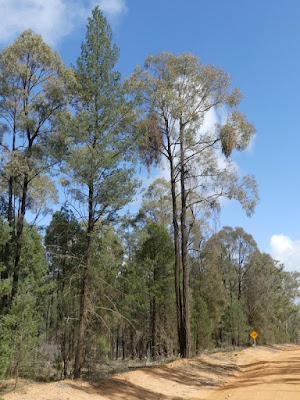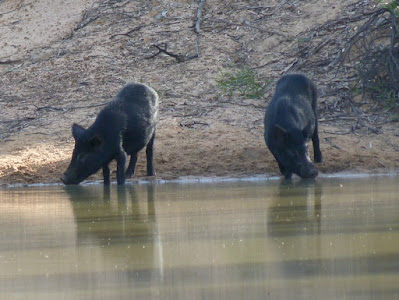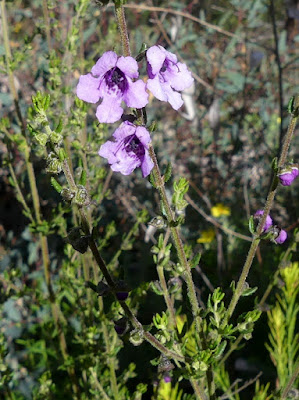On the north-western slopes of NSW, some 400km inland, is a mighty forest and woodland covering some half a million hectares (5000 square kilometres) of sandstone. It is divided roughly 50:50 between reserved land and state forest (subject to logging). The reserved areas comprise Timmillallie and Pilliga National Parks, Pilliga Nature Reserve and Pilliga East and Pilliga West State Conservation Areas (see map below). The Newell Highway, one of Australia's busiest inland highways which provides the NSW section of the main route between Melbourne and Brisbane, passes through the forest for nearly 90km. This accounts for most of the distance between the towns of Coonabarabran and Narrabri, and makes for a beautiful drive, but it's better still to make time to leave the highway and drive onto the quieter forest roads. Off the highway to the west, Barradine is home to the excellent visitor information centre. The Pilliga is a favourite destination of ours, though I realise we've only camped there twice - so much else to see and do! And I really can't believe that it hasn't previously featured in one of my blog posts.
 |
| A typical roadside scene in Timmillallie NP, with Pilliga Box Eucalyptus pilligaensis in the centre of the photo, and White Cypress Pine Callitris glaucophylla on the right. |
 |
| The Pilliga is approximately at the end of the red arrow, inland of the Great Dividing Range. See the next image for more detail. |
 |
| I'm afraid this is the best I can do to show you the reserves within the forest; click on it to enlarge, to compare with the previous satellite image. Coonabarabran is at the lower number 3, while Baradine is behind the left-hand number 4. Everything else that shows as forest on the satellite photo is state forest. Courtesy NSW NPWS, where you can also see the map much more clearly. |
In the Pilliga State Conservation Area, just south-west of Narrabri, 5800ha have been protected from feral predators (ie foxes, cats and dogs) by 32km of predator-proof fencing, in a partnership project between NPWS and the Australian Wildlife Conservancy. It is planned to rerelease seven threatened mammal species which are now locally extinct, and as far as I can tell so far three (Bilbies, Bridled Nail-tail Wallabies and Brush-tailed Bettongs) are already established. To clarify, those three have definitely been released and others may have been since the undated article I've been reading. For obvious reasons the area isn't open to the public, though there are occasional guided 'open days' so it would be worth your while enquiring if you're interested.
The previous photo of the trees pretty much sums up the forest, in that it is dominated by cypress pine and box eucalypts, though of course in an area that big there is plenty of variation. Most of the photos that follow are in Timmillallie NP, west of the highway.
 |
| Again there is cypress pine here, but the ironbarks (these are probably Red Ironbark E. sideroxylon) are also an important component. |
 |
| Belah Casuarina cristata, an important species in woodlands of the western slopes. |
 |
| Brown Bloodwood Corymbia (or Eucalyptus) trachyphloia. |
The sandstone itself isn't so easy to find, but an excellent example is east of the highway at Sandstone Caves, an important cultural site and a nesting site for Peregrine Falcons. It is near the southern end of the Pilliga Nature Reserve.
 |
| Typical sandstone cliffs at the site, where a walking track circumnavigates the impressive outcrops. Note the burnt tree trunks, which I'll get back to soon. |
 |
| Windblown caves, like the ones above and below, are fascinating (and very attractive) features of the cliffs. |
 |
| Petroglyphs, Sandstone Caves, above and below. |
 |
| View across Dandry gorge from the cliff top walk. |
 |
| Inside Dandry Gorge. |
A dry forest system such as dominates in the Pillliga is prone to wildfire and is adapted to a regime of it, but things are changing as we interfere with natural climatic systems. There have been two major wildfires in the Pilliga in the last six years. In January 2018 (two and a half years before we were last there) nearly 600 square kilometres (60,000ha) burnt, that is more than 10% of the entire forest, including much of Timmallallie. I pointed out burnt trees by the Sandstone Caves above, but the was stark evidence of the conflagration in most places where we were.
 |
| View from the Sandstone Caves cliffs, August 2020 |
 |
| The heathland at the Salt Cave area was very intensively burnt in 2018, but recovering as expected two and a half years later. |
 |
| Callitris regrowth (with heavy early morning dew) at the Sculptures in the Scrub campground. Callitris is mostly killed by fire and regenerates from seed. |
Here are a few animals we eoncountered over the years - nothing particularly unusual, but they're all worthy of note.
 |
| They are excellent climbers and investigate tree hollows for potential prey. This one went up the ironbark trunk... |
 |
| Peron's Tree Frog Litoria peronii is widespread in south-eastern Australia, and its mad cackle is a familiar night sound. |
 |
| Feral Pigs are of course an environmental problem anywhere in Australia. This family was disturbingly undisturbed by us across the dam. |
And a few common birds, but nonetheless worth presenting.
 |
| Collared Sparrowhawk Accipiter cirrocephalus, a fierce little bird-predator, found throughout the country. |
 |
| Noisy Friarbird Philemon corniculatus, a big (and yes noisy) migratory honeyeater. |
 |
| Red-capped Robin Petroica goodenovii, a glorious tiny inland robin (and a pretty sketchy photo!). |
 |
| Male Rufous Whistler Pachycephala rufiventris, another common migrant whose songs fill the drier forests and woodlands from spring to early autumn. |
 |
| Golden-top Wattle Acacia mariae, a NSW endemic found in woodlands in the north-east quarter of the state. The Pilliga is a noted site for it. |
 |
| Pilliga Wattle Acacia pilligaensis, originally described from the Pilliga, but also found in sandy soils from Dubbo to southern Queensland. |
 |
| Mudgee Wattle Acacia spectabilis (confusingly also called Pilliga Wattle), found widely in dry forests and Callitris woodlands on the western slopes of NSW and in south-east Queensland. |
 |
| Spurwing Wattle Acacia triptera, a hard spiky wattle which grows in sandy woodland and heathland west of the Divide in eastern Australia. |
 |
| Whorled Zieria Zieria aspalathoides Family Rutaceae; like many Pilliga plants this one is found more widely on the western slopes, though in this case from Victoria to tropical Queensland. |
 |
| Sandstone Boronia Boronia glabra Family Rutaceae; again found on sand or sandstone, north from Grenfell into south-east Queensland. |
 |
| Scaly Phebalium Phebalium squamulosum Family Rutaceae; grows on sandstone throughout much of eastern Australia |
 |
| Prostanthera howelliae has no common name that I'm aware of, so it is not abundant. Another one seemingly restricted to sandstone soils of the slopes. |
 |
| Chloanthes parviflora, another plant not common enough to warrant an accepted English name. A similar distribution, though scattered, to several previous species. |
 | |
| Grooved Dampiera Dampiera lanceolata, Family Goodeniceae; a familiar plant with a very wide distribution from northen NSW to far western South Australia. |
 |
| Purple Beauty Bush Dampiera adpressa, a much less common Dampiera than the previous one. |
 |
| Seven Dwarfs Grevillea (I love it!) Grevillea floribunda, a delightful small shrub which is widespread on the western slopes. |
 |
| Homoranthus flavescens, a lovely little shrub in the Myrtaceae family, another restricted to sandy soils, but only in north-eastern NSW. |
 |
| Small-leaved Daisy-bush Olearia microphylla is widespread in dry forests from Canberra to southern Queensland. |
 |
| Western Wedding Bush Ricinocarpos bowmanii, Family Euphorbiaceae, scattered in dry forest across the inland slopes and onto the plains. |
 |
| Leafy Templetonia Templetonia stenophylla. Apparently scattered widely west of the Divide, this one surprised me because the only other Templetonia I know has bright red flowers! |
I don't think I've taken enough photos to really show off the forest, but in many ways it's a subtle beauty which I must try harder to bring to life in future trips. I hope I've been able to do enough though to encourage you, next time you're driving up the Newell, to stop for a while in the Pilliga and have a look around. If you don't yet know it you might be pleasantly surprised.
 |
| Spring in the Pilliga. Pilliga Box over wattle. |
Should you wish to be added to it, just send me an email at calochilus51@internode.on.net. You can ask to be removed from the list at any time,or could simply mark an email as Spam, so you won't see future ones.
If you do leave a comment - and I love it when you do - please remember to click the
box below your comment that says 'Email follow-up comments to...[your address]'
so you'll know when I reply - and I always do!









